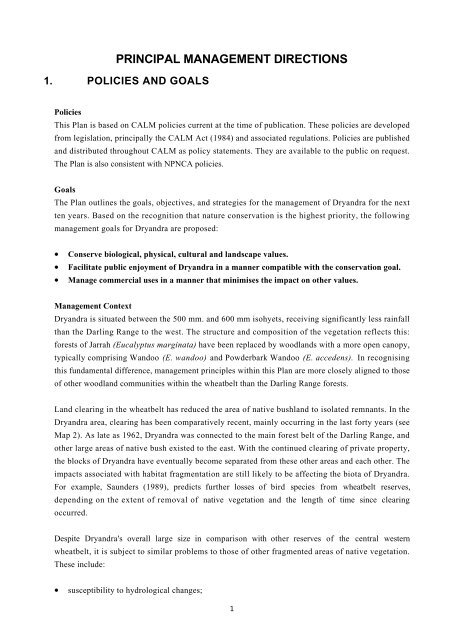Dryandra Woodland - Department of Environment and Conservation ...
Dryandra Woodland - Department of Environment and Conservation ...
Dryandra Woodland - Department of Environment and Conservation ...
You also want an ePaper? Increase the reach of your titles
YUMPU automatically turns print PDFs into web optimized ePapers that Google loves.
PRINCIPAL MANAGEMENT DIRECTIONS<br />
1. POLICIES AND GOALS<br />
Policies<br />
This Plan is based on CALM policies current at the time <strong>of</strong> publication. These policies are developed<br />
from legislation, principally the CALM Act (1984) <strong>and</strong> associated regulations. Policies are published<br />
<strong>and</strong> distributed throughout CALM as policy statements. They are available to the public on request.<br />
The Plan is also consistent with NPNCA policies.<br />
Goals<br />
The Plan outlines the goals, objectives, <strong>and</strong> strategies for the management <strong>of</strong> <strong>Dry<strong>and</strong>ra</strong> for the next<br />
ten years. Based on the recognition that nature conservation is the highest priority, the following<br />
management goals for <strong>Dry<strong>and</strong>ra</strong> are proposed:<br />
• Conserve biological, physical, cultural <strong>and</strong> l<strong>and</strong>scape values.<br />
• Facilitate public enjoyment <strong>of</strong> <strong>Dry<strong>and</strong>ra</strong> in a manner compatible with the conservation goal.<br />
• Manage commercial uses in a manner that minimises the impact on other values.<br />
Management Context<br />
<strong>Dry<strong>and</strong>ra</strong> is situated between the 500 mm. <strong>and</strong> 600 mm isohyets, receiving significantly less rainfall<br />
than the Darling Range to the west. The structure <strong>and</strong> composition <strong>of</strong> the vegetation reflects this:<br />
forests <strong>of</strong> Jarrah (Eucalyptus marginata) have been replaced by woodl<strong>and</strong>s with a more open canopy,<br />
typically comprising W<strong>and</strong>oo (E. w<strong>and</strong>oo) <strong>and</strong> Powderbark W<strong>and</strong>oo (E. accedens). In recognising<br />
this fundamental difference, management principles within this Plan are more closely aligned to those<br />
<strong>of</strong> other woodl<strong>and</strong> communities within the wheatbelt than the Darling Range forests.<br />
L<strong>and</strong> clearing in the wheatbelt has reduced the area <strong>of</strong> native bushl<strong>and</strong> to isolated remnants. In the<br />
<strong>Dry<strong>and</strong>ra</strong> area, clearing has been comparatively recent, mainly occurring in the last forty years (see<br />
Map 2). As late as 1962, <strong>Dry<strong>and</strong>ra</strong> was connected to the main forest belt <strong>of</strong> the Darling Range, <strong>and</strong><br />
other large areas <strong>of</strong> native bush existed to the east. With the continued clearing <strong>of</strong> private property,<br />
the blocks <strong>of</strong> <strong>Dry<strong>and</strong>ra</strong> have eventually become separated from these other areas <strong>and</strong> each other. The<br />
impacts associated with habitat fragmentation are still likely to be affecting the biota <strong>of</strong> <strong>Dry<strong>and</strong>ra</strong>.<br />
For example, Saunders (1989), predicts further losses <strong>of</strong> bird species from wheatbelt reserves,<br />
depending on the extent <strong>of</strong> removal <strong>of</strong> native vegetation <strong>and</strong> the length <strong>of</strong> time since clearing<br />
occurred.<br />
Despite <strong>Dry<strong>and</strong>ra</strong>'s overall large size in comparison with other reserves <strong>of</strong> the central western<br />
wheatbelt, it is subject to similar problems to those <strong>of</strong> other fragmented areas <strong>of</strong> native vegetation.<br />
These include:<br />
• susceptibility to hydrological changes;<br />
1

















